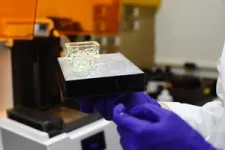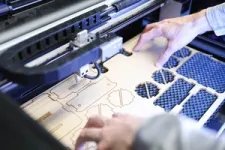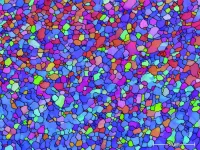(Press-News.org) Southfield, Mich., April 18, 2023 – For decades, researchers have marveled at the ability of glioblastoma, a particularly aggressive brain cancer, to turn off a patient’s cancer-fighting immune cells, thereby allowing tumors to grow freely. This remains a primary reason why there are very few effective therapies available for this mostly fatal disease.
In a new study using more than 100 patient-derived glioblastoma tumors, Prakash Chinnaiyan, M.D., a physician scientist in the Department of Radiation Oncology at Corewell Health in Southeast, Mich., along with colleague and lead author Pravin Kesarwani, Ph.D., have discovered that a naturally produced chemical in the body is helping glioblastoma cells go unrecognized by a patient’s own immune cells whose job it is to stop them.
“Specifically, we found that glioblastoma cells work with a patient’s immune system to generate a chemical called quinolinate,” Dr. Chinnaiyan said. “In turn, this chemical ‘puts the brakes’ on the surrounding immune cells and prevents them from attacking the tumor.”
The findings, published in Nature Communications, could be the key to unlocking new and more successful treatments down the road. While there have been some immunotherapy drugs that have been successful in reactivating a patient’s immune cells against certain cancers, none have worked on glioblastoma tumors and there are currently no available drugs to stop the production of quinolinate.
As a result, the team took their research one step further and created a genetically engineered mouse model that could no longer produce quinolinate.
“Tumors implanted in these mice grew significantly slower, and when analyzed in the lab, demonstrated robust immune activation, suggesting this pathway may serve as a new therapeutic target for glioblastoma,” Dr. Chinnaiyan said. “This provides a framework to design new immunotherapies that can target quinolinate accumulation associated with this disease and possibly others.”
As for next steps, Dr. Chinnaiyan said they will continue his research to help identify a compound that may be able to target quinolinate. The team also will look at extending their findings to other diseases such as Alzheimer’s and Parkinson’s where quinolinate accumulation has been found to be a potential factor as well.
“Our research may provide the key for better treatments and help save lives in the future, removing the mystery around glioblastoma and possibly other diseases,” Dr. Chinnaiyan said.
Additional study authors from the Chinnaiyan Lab at Corewell Health included research scientists Shiva Kant, Ph.D., Yi Zhao, Ph.D., Antony Prabhu, Ph.D., and Katie Buelow as well as C. Ryan Miller, M.D., Ph.D., with the Heersink School of Medicine at the University of Alabama at Birmingham.
About Corewell Health™
People are at the heart of everything we do, and the inspiration for our legacy of outstanding outcomes, innovation, strong community partnerships, philanthropy and transparency. Corewell Health is a not-for-profit health system that provides health care and coverage with an exceptional team of 60,000+ dedicated people—including more than 11,500 physicians and advanced practice providers and more than 15,000 nurses providing care and services in 22 hospitals, 300+ outpatient locations and several post-acute facilities—and Priority Health, a provider-sponsored health plan serving more than 1.2 million members. Through experience and collaboration, we are reimagining a better, more equitable model of health and wellness. For more information, visit corewellhealth.org.
###
END
WATERLOO, Ontario, April 18, 2023—Scientists from the Centre for Ocular Research & Education (CORE) are poised to unveil multiple advancements in 3D printing next week during the ARVO 2023 Annual Meeting in New Orleans. These innovations have widespread applications, with the potential to accelerate development of drug delivery systems, biodegradable contact lenses, and pharmaceuticals.
“Our multidisciplinary team has created one of the most sophisticated 3D printing environments for ocular research in the world,” said Alex Hui, OD, PhD, FAAO, head of Biosciences at CORE. “This ...
Curtin researchers have discovered how long ago the Australian Nullarbor plain dried out, with a new approach shedding light on how ancient climate change altered some of the driest regions of our planet.
Iron-rich layers formed in ancient sediments were used to narrow down when an area dried out in response to changes in climate, such as the dramatic decline of groundwater in southern Australia.
These ‘relics of drying’ suggest the Nullarbor drastically shifted to dry conditions between 2.4 and 2.7 million years ago, uncovering how these environmental changes were key in shaping Australia’s diverse ...
RICHLAND, Wash.—Scrap aluminum can now be collected and transformed directly into new vehicle parts using an innovative process being developed by the automotive industry, in particular for electric vehicles. Today, the Department of Energy’s Pacific Northwest National Laboratory, in collaboration with leading mobility technology company Magna, unveils a new manufacturing process that reduces more than 50% of the embodied energy and more than 90% of the carbon dioxide emissions by eliminating the need to mine and refine the same amount of raw aluminum ore. ...
COLUMBUS, Ohio – Having a four-year college degree and a low level of stress are strongly linked to psychological resilience in American women aged 80 and older, a new study suggests.
Researchers analyzed data from the Women’s Health Initiative to identify factors that are associated with higher self-rated resilience – the ability to weather storms and rebound from setbacks – among almost 30,000 women with an average age of 84.
Other characteristics linked to higher resilience included stronger social support, higher self-rated health and a lower risk of depression than levels among women ...
UC Riverside scientists are taking a modern approach to studying a murky subject — the quantity, quality, and sources of microplastics in Los Angeles County’s urban streams.
Microplastics are particles with a maximum diameter of 5 millimeters, roughly the size of a pencil eraser. The category can include nanoplastics, which are far smaller than the width of an average human hair.
Scientists have been aware that these particles have been filtering through the environment for decades, but concern about them has only started to ramp up more recently.
“There is mounting evidence that these materials are toxic,” said Andrew Gray, UCR assistant professor of ...
PULLMAN, Wash. -- A viable formula for a carbon-negative, environmentally friendly concrete that is nearly as strong as regular concrete has been developed at Washington State University.
In a proof-of-concept work, the researchers infused regular cement with environmentally friendly biochar, a type of charcoal made from organic waste, that had been strengthened beforehand with concrete wastewater. The biochar was able to suck up to 23% of its weight in carbon dioxide from the air while still reaching a strength comparable to ordinary cement.
The research could significantly reduce carbon emissions of the concrete industry, which is one ...
Barcelona, Spain – 18 April 2023: A score based on four readily available clinical and imaging parameters identifies the heart failure patients who benefit most from atrial fibrillation ablation, according to late breaking science presented at EHRA 2023, a scientific congress of the European Society of Cardiology (ESC).1
Atrial fibrillation and heart failure often coexist.2 It is estimated that approximately 30% of patients with heart failure will develop atrial fibrillation and patients with atrial fibrillation have a five-fold increased risk of developing heart failure.3 Each condition aggravates the prognosis of the other. Atrial fibrillation patients who develop ...
Responding to the increasing demand for sustainable energy research, IOP Publishing is launching a new open access (OA) environmental research journal. Environmental Research: Energy (EREN) will openly publish the latest findings around clean and sustainable energy for all. Aligned with a number of the UN’s Sustainable Development Goals (SDGs), the journal launch comes at a time when research output around renewable energy and sustainability has seen a 600% increase compared to ten years ago.
Environmental Research: Energy is the latest addition to IOP Publishing's expanding Environmental Research ...
Barcelona, Spain – 18 April 2023: An innovative three-step ablation approach including ethanol infusion of the vein of Marshall improves freedom from arrhythmias in patients with persistent atrial fibrillation compared to pulmonary vein isolation (PVI) alone, according to late breaking science presented at EHRA 2023, a scientific congress of the European Society of Cardiology (ESC).1 Preliminary results at 10 months are presented, with follow up ongoing until 12 months.
The cornerstone of catheter ablation of atrial fibrillation is complete isolation of the pulmonary veins.2 However, only 50–60% of patients remain in sinus rhythm at two years.3 Numerous ...
Barcelona, Spain – 18 April 2023: A novel software tool set to improve the management of elderly atrial fibrillation patients with multiple conditions is being designed by the EU-funded and ESC-coordinated EHRA-PATHS consortium. The latest updates on this clinical innovation will be presented at EHRA 2023, a scientific congress of the European Society of Cardiology (ESC).1
Scientific coordinator Professor Hein Heidbuchel said: “EHRA-PATHS is developing a standardised approach to ensure that patients with atrial fibrillation receive evidenced-based therapies for the comorbidities that underlie or complicate their heart rhythm disorder.”
Atrial ...







